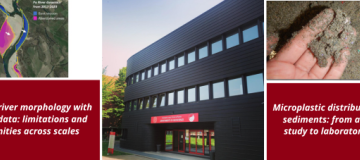
Seminars Excellence Project - November, 7
Speaker: Dr. Elisa Bozzolan | Thursday, November 7 at 4.30 pm - Arduino Room Speaker: Dr. Francesca Uguagliati | Thursday, November 7 at 5 pm - Arduino Room
07.11.2024
Monitoring river morphology with Sentinel 2 data: limitations and opportunities across scales - Dott.ssa Elisa Bozzolan
Satellite imageries are starting to become for geomorphologists a new tool to monitor medium large river dynamics at high revisit time. The Sentinel 2 mission, in particular, freely provides a multispectral image of the earth surface at 10 meters resolution every 5 days (cloud cover permitting). Machine learning algorithms can then classify these images automatically into river water, exposed sediment bars and riparian vegetation.
The spatiotemporal evolution of these geomorphic features can describe how a river responds to different hydrological impulses and boundary conditions, providing insights for future impacts. In this talk, I will give an overview of how Sentinel 2 images have been used within the Po River catchment (Italy) across different applications. Examples include the quantification of the intrinsic uncertainty that are present when using these tools (what can we actually map at 10 m resolution?) as well as the identification of river change hotspots within the last decade. This information can be used from reach‐ up to network‐scales, supporting a robust understanding of the underlying river processes but also informing river managers of where interventions can be most effective.
Microplastic distribution in river sediments: from a real case study to laboratory insights - Dott.ssa Francesca Uguagliati
Rivers, by draining urban regions and industrial areas, serve as critical pathways for transporting microplastics from land to oceans. During this transport, microplastics interact with sediments, potentially accumulating in alluvial deposits where they further fragment and release contaminants. Despite the significance of these processes, the mechanisms governing microplastic transport and deposition in rivers have rarely been examined according to fluvial sedimentology principles. To address this gap, we analysed deposits accumulated on alternate bars of the Arno River (Tuscany, Italy) following two major flood events.
Three distinct deposit types were sampled: i) plant debris, ii) clastic suspended deposits, and iii) bedload deposits. Our findings reveal that microplastics are easily trapped by floating plant debris and can also accumulate on bar tops and along riverbanks. Sand can incorporate microplastics during tractional flow and in the waning flood stages, while gravel efficiently traps them during recessional floods as water infiltrates and deposits suspended particles between clasts. Building on these results, laboratory flume experiments were conducted to investigate further the mechanisms behind microplastic‐sediment interactions. The experiments focused on how these processes control microplastic trapping in riverine deposits both under settling and tractional conditions.





